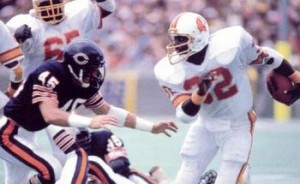In 1984, James Wilder had 407 carries for Tampa Bay at a time when the league was only beginning to shift away from running back by committee. In fact, by the end of the ’84 season, three of the highest single-season carry totals in NFL history had taken place that year, with Walter Payton and Eric Dickerson joining Wilder as true workhorses. The ’84 Bucs had the most concentrated rushing attack of any team in an era of increasingly concentrated rushing attacks.
Take a look: in ’84, Wilder had 1,544 rushing yards, which represented 86.94% of all Bucs rushing yards. The square of that is 75.58%; sum the squares of all players who gained rushing yards for Tampa Bay last year, and you get a concentration index of 75.87%.
The average team had a rushing concentration index of 35.5%, and the standard deviation among the teams in 1984 was 13.7%. As a result, Tampa Bay’s rushing concentration index was 2.96 standard deviations above average, known as the Z-Score. That was the 2nd most concentrated score from 1946 to 1984, snugly fit in between the 1966 Patriots (2.93) and 1967 Patriots (2.97).
In 1966, the Patriots led the AFL in rushing attempts and featured a two-back offense with Jim Nance (299 carries) and Larry Garron (101 carries). But since Nance averaged 4.9 yards per carry and Garron just 3.2, Nance wound up rushing for about 74% of the Patriots rushing yards that season. In ’67, New England ran less often, but Nance took a larger share of the load. He had 269 carries to Garron’s 46, and had 76% of all Patriots rushing yards in a very RBBC-centric era. From ’66 to ’67, Nance wasn’t just the top RB in the AFL but in all of pro football. Thanks to his heavy workload, he easily outrushed two HOF RBs in the primes of their career during those seasons.
The table below shows each team that had a Z-Score of at least 1.25 in rushing concentration. Here’s how to read it. In 1991, the Cowboys behind Emmitt Smith had 1,726 rushing yards. [1]This excludes any player who finished the season with negative rushing yards. The squared result of each player’s percentage — i.e., the concentration index — was 82.3%. The standard deviation among all teams that year was 13.9%, and the league average was just 33.9%, giving the ’91 Cowboys a Z-Score of 3.48. In other words, the ’91 Cowboys’ rushing attack was so concentrated for that season that it was 3.48 standard deviations above average. That’s why it ranks 1st in this metric.
It’s impossible to write about rushing concentration and not discuss Edgerrin James. He has six seasons in the top 61, but perhaps more impressively, his teams have 5 of the top 15 most highly concentrated rushing offenses in league history. That’s remarkable. Ditto goes for Jim Brown, whose teams basically finished 1st in 8 of his 9 seasons playing pro football.
References
| ↑1 | This excludes any player who finished the season with negative rushing yards. |
|---|

